AI in Business: Applications, Benefits, Challenges & 2025 Trends

Chris Raroque
Co-Founder

Share to AI
Ask AI to summarize and analyze this article. Click any AI platform below to open with a pre-filled prompt.
Has it ever seemed to you like it’s no longer optional to incorporate AI in business? If so, that’s because AI isn’t just another technology trend. We’re seeing a fundamental shift as transformative as the Industrial Revolution. Except in 2025, it’s going to last only a matter of years, rather than decades.
At Aloa, we work with tech-forward business leaders like you who are interested in what AI can do for your business. Whatever AI-powered features you might need, we help you cut through the hype and deliver custom AI solutions that drive measurable business outcomes.
In this article, we’ll take an in-depth look at exactly how AI transforms business operations, covering:
- AI’s business impact
- Common misconceptions
- Strategic implementation framework
- Future AI prospects
Whether you're just starting your AI journey or looking to scale existing initiatives, you'll find actionable strategies to position your organization for the AI-native economy.
AI – A New Beginning, Not an End
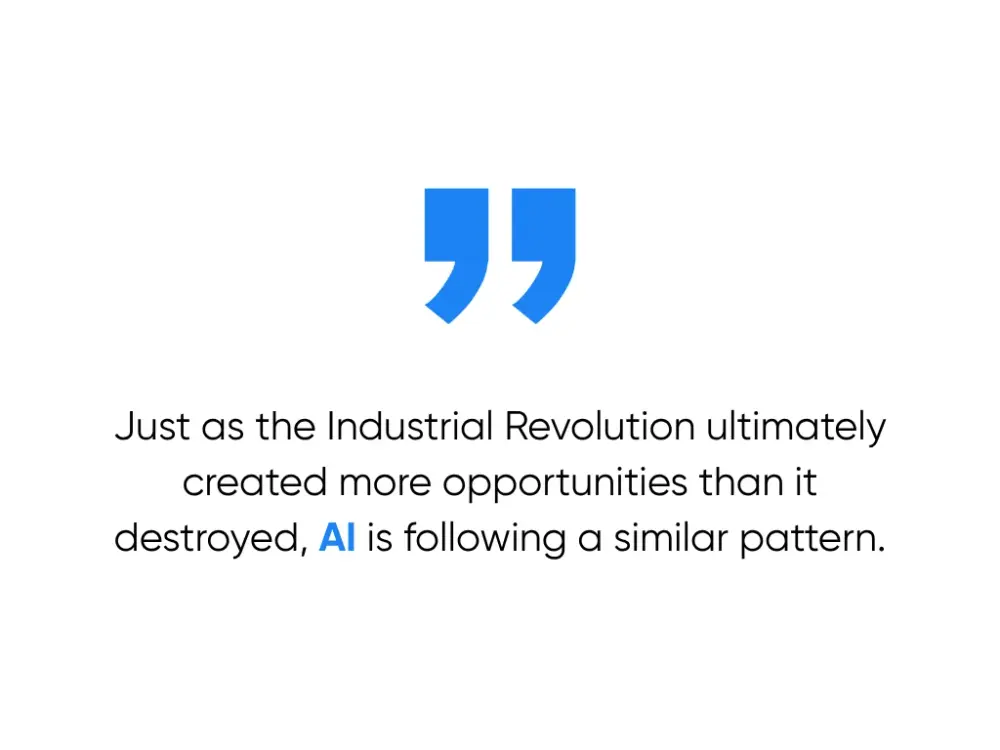
History offers a profound lesson about the transformative power of technology. Research from Columbia Business School shows that the arrival of AI in business closely resembles the impact of the Industrial Revolution. The adoption of artificial intelligence is leading to a 5 percent decline in the labor share of income. For perspective, the Industrial Revolution led to up to a 15 percent decline in the labor share of income.
And just as the Industrial Revolution ultimately created more opportunities than it destroyed, AI is following a similar pattern. While the onset of the Industrial Revolution was not without its problems, it ultimately led to more employment opportunities in the long run.
The World Economic Forum believes as much. Based on data from more than 1,000 companies, the WEF projects 170 million new roles by 2030 to offset the 92 million expected to be displaced. This is a net increase of 78 million jobs.
Understanding AI's Role and Overcoming Misconceptions
One of the biggest barriers to the adoption of AI in business stems from widespread misconceptions, particularly the fear that "AI will take our jobs." But history shows us that major technological advancements, like the internet, transform jobs rather than eliminating them. Here’s how AI is augmenting human capabilities:
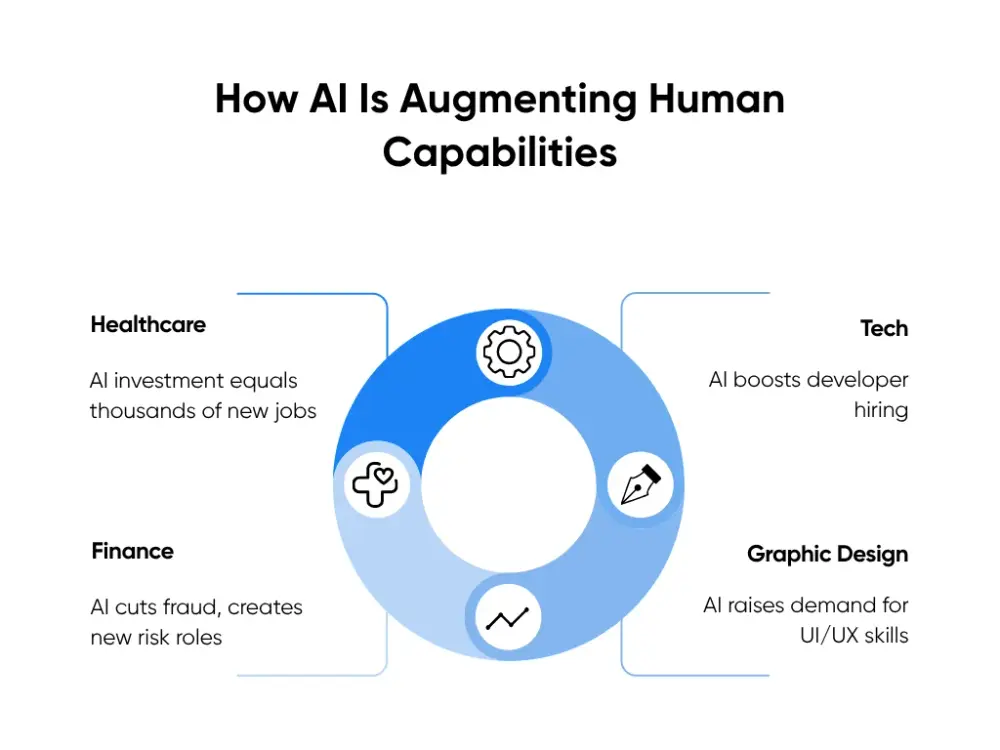
- Healthcare: Big pharma companies are going all-in on healthcare AI. Roche built a new AI R&D center in Massachusetts. Novartis dropped $1.2 billion on Google DeepMind for drug discovery. The result? Thousands of new specialized jobs.
- Finance: Finance was one of the first adopters of AI tech. JPMorgan Chase cut fraud by over 50% using AI. Goldman Sachs improved trading efficiency by 40%. Now they're hiring AI risk analysts and algorithmic oversight specialists.
- Tech: Microsoft spent $650 million acquiring 70 AI specialists. OpenAI grew to over 700 employees. Companies using AI tools like GitHub Copilot are actually hiring more developers.
- Graphic design: AI can automate 26% of design tasks. UI and UX designers are among the fastest-growing roles as companies need human-centered design expertise.
AI has also created entirely new job categories, including prompt engineers, AI trainers, data specialists, and security specialists. With demand surging, companies are paying 25% more for AI-ready talent. Aloa’s AI development services let you skip the oncoming talent bottleneck with instant access to a complete AI development team made up of former Google and Amazon engineers.
How AI Supports Business Needs
Still think AI is just hype? The numbers tell a different story. Companies are seeing real, measurable returns across three game-changing areas where AI is transforming how business gets done.
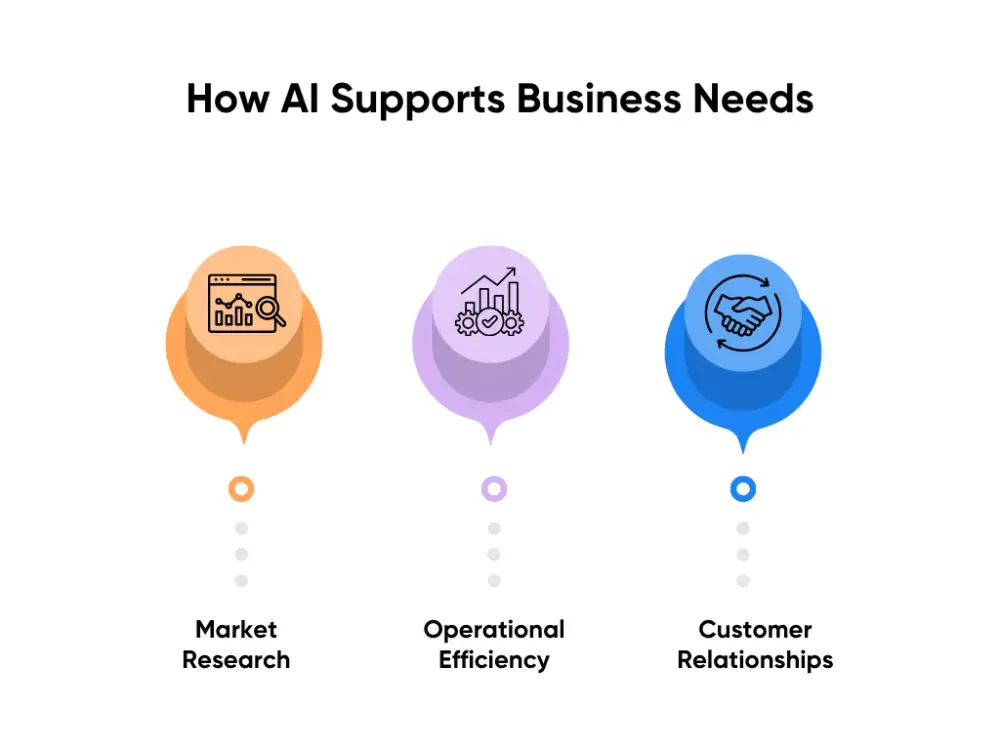
Market Research
With AI, we no longer have to wait for weeks before trend reports can come in. AI-powered predictive data analytics now deliver actionable insights in real time. These help companies react instantaneously to market shifts and spot opportunities before competitors even know they exist.
The results speak for themselves: 83% of sales teams using AI report revenue growth compared to just 66% without AI. What’s more is that 80% of AI-equipped sales reps say getting customer insights is easy, while only 54% without AI tools can say the same.
Operational Efficiency
AI is a maverick at optimizing operating costs and procedures. Take UPS's ORION system, which saves 10 million gallons of fuel annually, equating to $400 million in cost savings and 100,000 metric tons in cut carbon emissions.
In manufacturing, predictive maintenance cuts equipment failures by 70% and increases productivity by 25%, with companies like Deloitte's logistics client using AI sensors to identify equipment lifespan across facility networks and target maintenance before failures occur.
The pattern holds across industries: AI process automation improves operational efficiency by an average of 40%, with 88% of employees saying generative AI helps them save time and make faster decisions.
Customer Relationships
Netflix figured this out early: their personalization engine drives over 80% of viewed content through recommendations, saving the company $1 billion annually in customer retention while saving users 1,300 hours daily in search time.
Meanwhile, AI sentiment analysis hits 95% accuracy in categorizing feedback, letting companies like T-Mobile spot and fix problems before customers even complain. For employees, the benefits of AI are just as real. Sales reps working with AI are 2.4 times less likely to feel overworked.
The bottom line? Organizations see an average $3.70 return for every dollar invested in generative AI, with top performers hitting $10.30 returns.
Strategic Implementation of AI
Successfully implementing AI isn't about jumping on the latest trend. The key is to take a methodical approach that aligns with your business goals. Follow this proven three-step framework to turn AI from a buzzword into a competitive advantage.
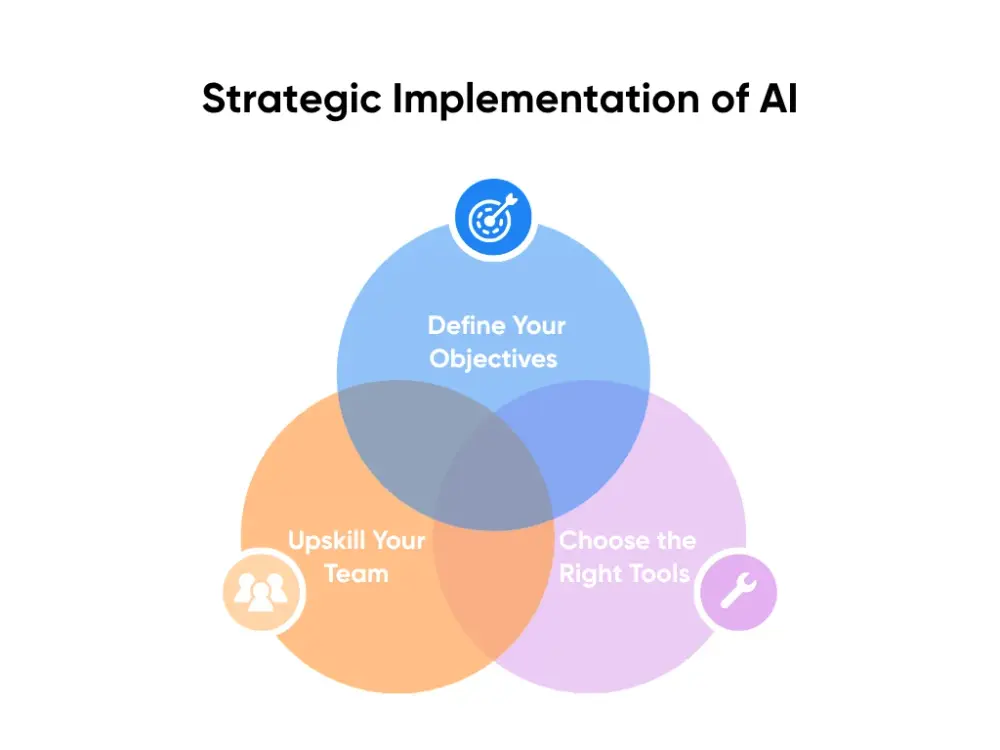
1. Define Your Objectives
Start by identifying where AI can deliver the biggest impact for your business. Don't try to solve everything at once. Focus on specific pain points where AI can provide measurable value.
Determine whether that's automating customer service, improving inventory management, or enhancing marketing personalization. The most successful implementations start with clear, achievable goals rather than vague aspirations to "use more AI."
2. Choose the Right Tools
With thousands of AI tools available, selection can feel overwhelming. Keep your business objectives in mind to zero in on the best fit.
For example, retail companies looking to enhance customer experience might select Algolia over Adobe Live Search for personalized product recommendations because of its compatibility with all ecommerce systems and front-end architectures. Similarly, an equipment manufacturer might choose Infor Nexus instead of Blue Yonder for supply chain management. Infor offers direct bank connection capability, which gives quick access to financing with the push of a button.
The key is matching tools to specific outcomes rather than choosing based on popularity or features alone.
3. Upskill Your Team
Technology is only as good as the people using it. This makes continuous learning and training to maximize competency with AI invaluable.
This means rolling out comprehensive training programs, from AI literacy workshops for all staff to specialized training for key departments. Financial services firms, for example, often implement "AI literacy workshops for all staff, specialized training for key departments, and continuous learning opportunities through online courses and certifications."
Companies that succeed at AI implementation treat it as an ongoing process of learning, adapting, and optimizing rather than a one-time technology upgrade. With Aloa’s AI dev services, that’s exactly what you’ll be getting. Our iterative approach and commitment to AI education ensure that your team stays informed and your AI solution is ever-evolving.
The Future of AI in Business
2025 marks the definitive transition from AI experimentation to AI-native business operations. Market projections range from $243-638 billion for 2025, reaching up to $4.8 trillion by 2030, while 92% of companies plan to increase AI investments over the next three years.
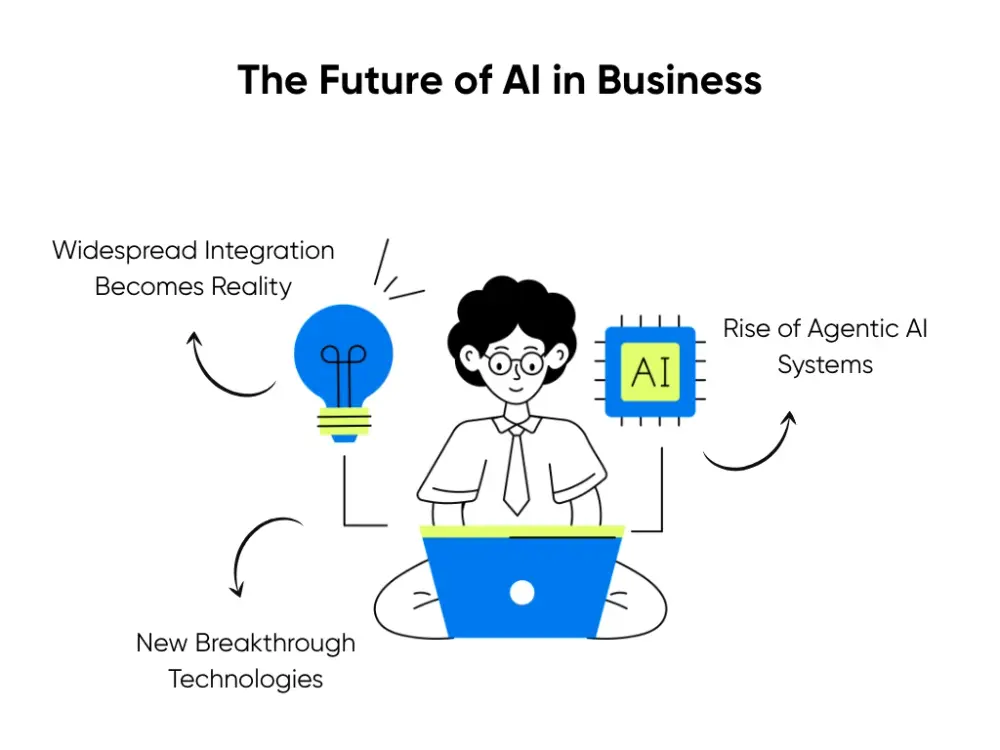
Widespread Integration Becomes Reality
AI integration is materializing faster than anticipated, with AI embedded in virtually every business process by year-end. Small and medium enterprises now access user-friendly, cloud-based AI tools requiring minimal technical expertise.
Industry adoption varies but accelerates universally: financial services lead, manufacturing targets 2026-2027 for widespread adoption, and healthcare anticipates mainstream deployment by 2026. Organizations have 18-24 months to establish AI-native capabilities or risk permanent competitive disadvantage.
The Rise of Agentic AI Systems
The dominant trend is agentic AI, autonomous systems executing complex workflows without constant oversight. 25% of enterprises using generative AI will deploy AI agents by 2025, rising to 82% by 2026. These sophisticated systems manage supply chains, conduct customer service, and participate in strategic planning. Gartner predicts 15% of day-to-day business decisions will be made autonomously through agentic AI by 2028.
New Breakthrough Technologies
After widespread integration, converging technologies are driving the next digital transformation. These include:
- Multimodal AI: Can process text, audio, video, and images simultaneously
- Advanced reasoning models: Capable of complex problem-solving
- Specialized small language models: Chatbots with more tightly-scoped knowledge bases for cost-effective deployment.
Conclusion
With AI investment returning up to $3.70 on the dollar and 78 million new jobs created in spite of AI disruption, AI in business is nothing short of revolutionary. In what has come to be called the Fourth Industrial Revolution, the AI-native economy is already here.
Ready to transform your business with AI? Explore Aloa's comprehensive AI solutions and discover how we can help you implement the right tools for your unique challenges. Your AI-powered future starts today.
Frequently Asked Questions
How is AI transforming market research?
AI delivers real-time insights instead of waiting weeks for traditional reports. It analyzes social media, reviews, and purchasing patterns to identify market trends before competitors, enabling faster, more accurate decision-making through instant consumer behavior analysis.
What are common misconceptions about AI in business?
The biggest myth is "AI will take our jobs." Reality: AI creates 78 million net new jobs globally by 2030. Other misconceptions include believing AI is only for large corporations or requires extensive technical expertise. Modern AI tools are accessible and user-friendly for all business sizes.
How can small businesses adopt AI affordably?
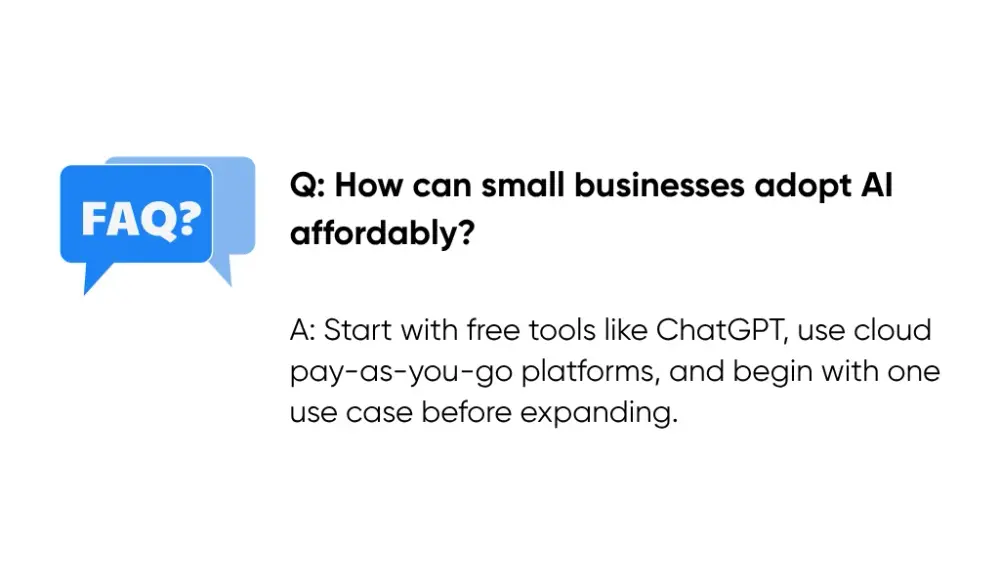
Start with free tools like ChatGPT for content or Google Analytics for insights. Use cloud-based platforms with pay-as-you-go pricing. Begin with one specific use case, such as customer service automation or sales analysis, then expand gradually.
Will AI replace human creativity in business?
AI enhances creativity rather than replacing it. While AI handles data processing and repetitive tasks, humans provide emotional intelligence, strategic thinking, and innovation. The most successful businesses make use of AI to free employees for relationship building and creative problem-solving.
What's the ROI timeline for AI implementation?
Organizations typically see returns within 3-6 months, with full ROI in 12-18 months. Companies achieving $10+ returns focus on solving specific problems rather than implementing AI for its own sake. Success requires proper planning and clear business objectives.